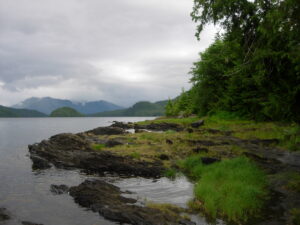The Case For Protecting The Tongass National Forest, America’s ‘Last Climate Sanctuary’

Tongass National Forest. – Photo: en.wikipedia.org
The “lungs of North America,” the Tongass National Forest is the Earth’s largest intact temperate rainforest. Protecting it means protecting the entire planet.
Spanning 16.7 million acres that stretch across most of southeast Alaska, the Tongass National Forest is the largest national forest in the United States by far and part of the world’s largest temperate rainforest. Humans barely inhabit it: About the size of West Virginia, the Tongass has around 70,000 residents spread across 32 communities.
A vast coastal terrain replete with ancient trees and waterways, the Tongass is a haven of biodiversity, providing critical habitat for around 400 species, including black bears, brown bears, wolves, bald eagles, Sitka black-tailed deer, trout, and five species of Pacific salmon.
The Tongass is a pristine region that supports a vast array of stunning ecosystems, including old-growth forests, imposing mountains, granite cliffs, deep fjords, remnants of ancient glaciers that carved much of the North American landscape, and more than 1,000 named islands facing the open Pacific Ocean—a unique feature in America’s national forest system.
The Tongass “is the crown jewel of America’s natural forests,” declared then-Senator Barbara Boxer (D-CA) during Senate deliberations of Interior Department budget appropriations in 2003. “When I was up there, I saw glaciers, mountains, growths of hemlock and cedar that grow to be over 200 feet tall. The trees can live as long as a thousand years.”
The National Forest Foundation calls the Tongass National Forest “an incredible testament to conservation and nature.” But since the 1950s, the logging industry has prized the forest, and the region has been threatened by companies that seek to extract its resources—and the politicians who support these destructive activities.
America’s Largest Carbon Sink
Carbon sinks absorb more carbon from the atmosphere than they release, making them essential to maintaining natural ecosystems and an invaluable nature-based solution to the climate crisis. Between 2001 and 2019, the Earth’s forests safely stored about twice as much carbon dioxide as they emitted, according to research published in 2021 in the journal Nature Climate Change and available on Global Forest Watch.
The planet’s forests absorb 1.5 times more carbon than the United States emits annually—around 7.6 billion metric tons. Consequently, maintaining the health of the world’s forests is central to humanity’s fight against climate change. But rampant deforestation and land degradation are not only removing this invaluable climate-regulating ecosystem service and supporter of biodiversity but also disturbing a healthy, natural planetary system that has existed for millennia.
“There is a natural carbon cycle on our planet,” said Vlad Macovei, a postdoctoral researcher at the Helmholtz-Zentrum Hereon in Germany. “Every year, some atmospheric carbon gets taken up by land biosphere, some by the ocean, and then cycled back out. These processes had been in balance for the last 10,000 years.” Read more
Why China’s New Map Of Its Borders Has Stirred Regional Tensions

John P. Ruehl – Source: Independent Media Institute
10-17-2023 ~ China’s release of its standard map has produced outrage and alarm in several countries, yet Beijing remains steadfast in continuing its historical approach toward its borders.
In the waning days of August 2023, closely following a BRICS summit and mere days ahead of the Association of Southeast Asian Nations (ASEAN) and G20 meetings, Beijing revealed its latest seemingly innocuous “standard” map. Having been released regularly since at least 2006, China’s standard maps are aimed to eliminate “problem maps” that do not affirm China’s territorial integrity. But the 2023 edition invited ripples of condemnation throughout China’s near abroad and beyond, as it repeated Beijing’s claims on divisive territorial disputes with its neighbors—including the Philippines, which has seen its struggle with China over a small shoal in the South China Sea escalate significantly over recent weeks.
The release of China’s map, coupled with its aggressive border strategies, has created enormous uncertainty across the Indo-Pacific. In a rapidly evolving geopolitical landscape, various actors are wrestling with how to effectively counter China’s actions.
China’s perception of maritime and international laws as products of Western customs has underpinned its level of adherence to them. “Stealthy compliance” allows China to ambiguously accept international law while interpreting it flexibly to advance its territorial claims. Beijing will also explicitly reject international law, exemplified by its dismissal of a tribunal in The Hague that challenged China’s assertions in the South China Sea in 2016. Regularly publishing maps helps assert China’s claims to domestic and international audiences, without putting Beijing in a position where it has to enforce them simultaneously.
Beijing’s strategy has effectively thwarted regional and Western responses and prevented the outbreak of major conflict. Inflaming territorial disputes serves as a bargaining chip in bilateral negotiations and lays the groundwork for potential future claims as China’s strength is expected to increase. Channeling nationalist sentiment outward has also bolstered the Chinese government’s domestic legitimacy and diverted attention from contentious issues like Tibet, Xinjiang, and Hong Kong.
However, the response to China’s 2023 map reveals growing backlash to Beijing’s approach to its border issues and questions over its long-term sustainability.
China has periodically unveiled its nine-dash line map for decades, delineating its claims in the South China Sea. The mystery shrouding whether these claims pertain to water rights, land features, or both, has kept the region on edge. Regardless, they symbolize China’s desire to reduce U.S. control over regional shipping lanes, secure rights over natural resources, and project power beyond its first island chain into the expansive Pacific.
China’s latest map took a bold step by reintroducing a tenth dash east of Taiwan—a largely dormant claim since 2013. The move not only reaffirmed China’s ownership of Taiwan but also extended China’s reach beyond Taiwan’s recognized territorial waters, a direct challenge to the United Nations Convention on the Law of the Sea (UNCLOS). Reasserting this claim may point to growing confidence in Beijing of being able to impose its various claims in the region. China’s map also continued to emphasize China’s rights to the Senkaku Islands, disputed with Japan. Both Taipei and Tokyo vehemently criticized China for the map’s release.
China and ASEAN had meanwhile been negotiating a code of conduct for the South China Sea, reaching an agreement in July to accelerate the process. The release of the 2023 map just days before the ASEAN summit in Indonesia naturally triggered swift rejection from member states such as Malaysia, the Philippines, and Vietnam, which have longstanding wariness of Chinese maritime territorial ambitions. Read more
G7 Versus BRICS: Power Struggles Are Not Class Struggles

Richard D. Wolff
Class struggles interact with but are different from power struggles. The ancient conflicts between city-states Athens and Sparta were power struggles, while within each, slaves and enslavers engaged in class struggles. Britain and France were absolute monarchies in late European feudalism fully engaged in power struggles. At the same time, class struggles between lords and serfs internally agitated both “great” powers. Now, after slavery and feudalism have largely ended and capitalism prevails globally, great power struggles exist between the G7 and BRICS and among their member nations, as well as other nations. At the same time, class struggles exist between employers and employees in all nations. Power and class struggles condition and shape one another. Both have been and remain core aspects of history; so too have ideological habits of confusing and conflating them.
Kaiser Wilhelm II, Germany’s monarch, said in 1914 as World War I began, “I no longer recognize [political] parties, I recognize only Germans.” He used nationalism to unify a class-divided Germany to help win the war. The Kaiser had been shaken by more than the increasingly serious struggles among world powers over colonies, world trade, and foreign investment. He was stunned too by the rise of Germany’s Marx-inspired Socialist Party across the decades before the war. Germany’s class of capitalist employers had been similarly shaken and stunned. For a country increasingly and deeply split between labor and capital, German nationalism was the employer class’s strategy both to thwart socialism and win the war. Key to that strategy was getting people to think (and self-identify) in terms of national and ultimately military struggles, and not class struggles.
Germany’s strategy failed. It lost World War I, the monarchy ended, and its Socialist Party became Germany’s postwar government. Socialism emerged from the war far stronger in Germany than it had ever been. Much the same was true for World War I’s other combatant nations. More or less all of them had used nationalism to mobilize their war efforts and to undermine and displace class consciousness. For the war’s winners, nationalism may have served its purpose for them to achieve victory. Yet, it did not vanquish or banish socialism. Instead, socialism captured its first government (Russia) and split into socialist and communist wings that each drew mass attention and engagement. Both wings spread globally and quickly in the 1920s and even more in the 1930s as capitalism imposed its worst crash ever on most nations across the world.
Now, a century later, power struggles intensify and sharpen across global capitalism. The power of the United States, hegemonic during the Cold War, is now declining. The earlier decline of Europe, punctuated by the loss of its colonies and two deeply destructive world wars, continues. Both Europe and the United States face the stunning, unprecedented speed of China’s economic growth and concomitant rise to global power status. Already, China’s network of alliances, especially the BRICS, confronts the United States and its alliances, especially the G7. The rise of China and the BRICS adds to their power struggles with the United States and the G7. That rise is also realigning power relations between the Global North and Global South and, in one way or another, among all nations and within international organizations.
Class struggles have likewise continued in all societies, thereby evolving in different forms and foci. Most importantly, socialists now focus decreasingly on the struggle between private property and free markets as capitalism, versus state property and state planning as socialism. Many socialists reacted to 20th-century experiences with state power in the USSR and the People’s Republic of China by shifting their focus. State power and planning, while not dismissed as socialist goals, were seen increasingly as insufficient by themselves. Something more or different was needed to yield the post-capitalist system that socialists could and would embrace. Socialists refocused their priorities on the transformation of workplaces. Based on a critique of the capitalist hierarchy inside factories, offices, and stores—and its social effects—socialists increasingly stress proposals to democratically reorganize production there. Each worker in an enterprise will have an equal vote to decide what, where, and how to produce as well as how to dispose of the product (or net revenues where the product is marketed). The democratization of all workplaces (households as well as enterprises) becomes a central thrust of what socialism has come to mean. Read more
‘Sacrifice Zones’: The New ‘Jim Crow’ That’s Sickening And Killing People Of Color

Reynard Loki
A product of entrenched, historic racism, “sacrifice zones”—designed to site pollution hot spots within communities of color—are a front line in a largely silent, often deadly, and steadily growing health crisis across the United States.
The Black Lives Matter movement and the COVID-19 pandemic have highlighted how systemic racism disproportionately places danger and harm on low-income and minority populations. One harsh reality of this systemic racism is the existence of “sacrifice zones”: Communities located near pollution hot spots that have been permanently impaired by intensive and concentrated industrial activity, such as factories, chemical plants, power plants, oil and gas refineries, landfills, and factory farms.
As noted by the Climate Reality Project, an environmental nonprofit based in Washington, D.C., “These areas are called ‘sacrifice zones’ because the health and safety of people in these communities [are] being effectively sacrificed for the economic gains and prosperity of others.”
Designated by corporations and policymakers, these areas are a product of environmental racism: the systemic social, economic, and political structures—including weak laws, lack of enforcement, corporate negligence, and limited access to health care—that place disproportionate environmental health burdens on specific communities based on race and ethnicity.
Because people of color and low-income groups in the United States are most likely to live in sacrifice zones, they breathe polluted air, drink contaminated water, and are exposed to a variety of toxic chemicals and particulate matter. More than 50 percent of residents who live near hazardous waste are people of color, with Black Americans 75 percent more likely to live near these sites. Considering these facts, it is no surprise that communities of color have a higher chance of dying from environmental causes than white people.
“Thirty-nine percent of the people living near coal-fired power plants are people of color, so what’s absolutely true is that there are a disproportionate number of people of color living next to these plants,” then-senior director of the environmental and climate justice program at the NAACP, Jacqueline Patterson, told Yale Environment 360 in June 2013. Speaking after the release of an NAACP report on the disproportionate effects of coal-fired plants on minorities, Patterson further added that “[s]eventy-eight percent of African Americans live within 30 miles of a coal-fired power plant. We also discovered that Latino communities, as well as Indigenous communities and low-income communities, are more likely to live next to coal-fired plants.”
Entrenched Inequity
Sacrifice zones are a consequence of an “extractive development model” supported by self-serving government officials who want to create job and income opportunities provided by polluting industries rather than avoiding irreversible damage caused by these industries to communities of color. “Sacrifice zones are the result of many deeply rooted inequities in our society. One of these inequities takes the form of unwise (or biased) land use decisions, dictated by local or state officials, intent on attracting big industries to the town, county, or state, in an effort to create jobs and raise tax revenues,” wrote Steve Lerner in his 2012 book Sacrifice Zones: The Front Lines of Toxic Chemical Exposure in the United States. “When decisions are made about where to locate heavily polluting industries, they often end up sited in low-income communities of color where people are so busy trying to survive that they have little time to protest the building of a plant next door. Those who make the land use decisions that govern sacrifice zones typically designate these areas as residential/industrial areas, a particularly pernicious type of zoning ordinance.”
“In these areas, industrial facilities and residential homes are built side by side, and few localities have adequate buffer zone regulations to provide breathing room between heavy industries and residential areas,” Lerner continued.
The polluting environment results in an increased prevalence of health problems among residents living near heavy industries. “The health impact of this patently unwise zoning formula is predictable: [R]esidents along the fenceline with heavy industry often experience elevated rates of respiratory disease, cancer, reproductive disorders, birth defects, learning disabilities, psychiatric disorders, eye problems, headaches, nosebleeds, skin rashes, and early death. In effect, the health of these Americans is sacrificed, or, more precisely, their health is not protected to the same degree as citizens who can afford to live in exclusively residential neighborhoods,” stated the book.
The Center for Health, Environment & Justice, a nonprofit environmental activism group based in Falls Church, Virginia, asserted that “[d]ue to redlining, low property values, and other social factors, these communities have historically consisted of [low-income] and/or minority populations.”
The group pointed out that “federal air policies regulate facility emissions one stack at a time and one chemical at a time. Impacted communities, however, are exposed to the cumulative impact of multiple pollutants released over an extended period of time from a cluster of facilities.” Read more
Palm Oil: The Ingredient Behind Human Rights Abuses And Eco-Destruction That’s Probably In Your Home Right Now

Palm oil – Ills.: nl.wikipedia.org
Palm oil is found in 50 percent of all consumer goods. And it’s killing the environment.
“Oil palm is one of the world’s most prominent and effective vegetable oils globally, and is contributing 40 percent of global trade volume in vegetable oils,” said Beatriz Fernandez, who manages the United Nations Environment Programme (UNEP)’s partnership in the GCRF Trade, Development and the Environment Hub, during a high-level dialogue held on August 30, 2022, in Jakarta and online, to discuss the situation of the sustainable palm oil trade in Indonesia in light of the shocks to the global food system spurred by the COVID-19 pandemic.
According to the Center for International Forestry Research, a nonprofit scientific research organization, the challenges for the sustainable palm oil sector include “the need to align policies and development goals with the country’s biodiversity, climate change and sustainable development commitments; coordination of various certification mechanisms; and limited capacity of smallholder farmers to comply with sustainability standards.”
Palm Oil: Violent Business
Another challenge is violence. In May 2020, the village Ijaw-Gbene in southern Nigeria was burnt to the ground, leaving more than 80 people without homes. According to a report by Chief Ajele Sunday, the spokesman of the people of the Okomu Kingdom, witnesses identified the perpetrators as members of the security force employed by the Okomu Oil Palm Plantation supported by soldiers in the Nigerian army. At the time, Ijaw-Gbene was the fourth village in the region to experience such an attack.
Joseph Miyani, one of the victims of the attack, said that the company’s security forces and government soldiers fired weapons “before setting our houses ablaze.” He reported that villagers fled into the bush to escape the violence, even jumping into a nearby river to protect themselves. “Since that day my life has been miserable … I don’t know where to start,” Miyani said. “We are now taking shelter in a church building.”
Okomu is a subsidiary of Société Financière des Caoutchoucs (SOCFIN), an agribusiness corporation that operates palm oil and rubber plantations across 10 Asian and African countries. “In Cameroon, Liberia, Sierra Leone, Ivory Coast, and Cambodia, local people complain about ruthless methods wherever [SOCFIN’s] subsidiaries are active,” reports Rainforest Rescue, a nonprofit environmental organization based in Hamburg, Germany. “Repeatedly, after losing their lands to the company, local communities in Africa and Asia have been subject to violence, intimidation, and distress as a result of the palm oil and rubber exploitation,” writes Frédéric Mousseau, policy director at the Oakland Institute, a think tank based in Oakland, California, that focuses on social, economic and environmental issues.
Though Okomu denied their participation in the attack, violence and destruction are increasingly commonplace throughout the global palm oil industry. In November 2020, the Associated Press (AP) reported on incidents of sexual abuse, rape, human trafficking, child labor, and slavery. “Almost every plantation has problems related to labor,” said Hotler Parsaoran of the Sawit Watch, an Indonesian nonprofit that has investigated abuses in the palm oil sector. “But the conditions of female workers are far worse than men.”
Driving Deforestation
In addition to its role in human rights abuses, the palm oil industry is also a primary driver of deforestation, which not only exacerbates climate change by releasing into the atmosphere carbon that was previously safely stored in trees cut down to make room for plantations, but threatens wildlife and biodiversity. Parsaoran told the AP that ending these abuses is the responsibility of palm oil producers, multinational buyers, governments, and the banks that finance plantations. But there is another powerful group that supports this entire industry: consumers. As Martin Hickman reports for the Independent, unwitting consumers “may be contributing to the devastation of the wildlife-rich forests of Indonesia and Malaysia, where orangutans and other species face extinction as their habitat disappears.” Read more
What If UFOs Have Been A Cover For High-Tech—And Human—Defense Research Programs?

John P. Ruehl – Source: Independent Media Institute
10-05-2023 ~ A mix of government, private, adversarial, and unexplained objects are filling up an increasingly congested U.S. airspace. Uncovering what fills it should be of greater public interest.
Could the decades-long pursuit of unraveling the UFO mystery potentially function as a cover for advanced government research and testing programs for innovative forms of propulsion and craft design? Moreover, might the recent rollout of official government hearings signal a gradual disclosure of some of those capabilities? This scenario is worth considering, as the process of investigating UFOs comes into sharper public focus.
In 2023, fascination with Unidentified Flying Objects (UFOs) and Unidentified Aerial Phenomena (UAP) has spiked. David Grusch, a former intelligence official who led the analysis of UAPs within the U.S. military, told a Congressional hearing in July that the United States had been collecting non-human craft “for decades.” At the first Republican debate on August 23rd, candidates were asked about the president’s responsibility to provide information to the public about UFOs. And on August 31st, the Pentagon launched a new website providing the public with declassified information about sightings.
Mainstream intrigue surrounding UFOs was born following the 1947 Roswell incident, the crash of what was initially described by the U.S. military as a “flying disc” in Roswell, New Mexico, but later attributed to a weather balloon. To quell public fear and speculation, official government studies to investigate UFO/UAP reports, including Project Blue Book, Project Sign, and Project Grudge, were launched. While the government feared air warning systems could be overwhelmed by reports, it was also wary of Soviet attempts to boost false sightings and promote conspiracy theories that could instigate panic and allegations of a coverup.
During the Cold War, UFO reports became common, often coinciding with missile and rocket tests (a habit which continues today). Several Soviet and U.S. military personnel also testified that UFOs were able to temporarily take control over missile and nuclear facilities. However, in 1997, the CIA revealed that the military had lied to the public throughout the Cold War about many UFO sightings to obscure its black projects and keep Moscow in the dark about technological advancements. Blaming sightings on natural phenomena like ice crystals and temperature inversions fueled public distrust toward the government and its claims about UFOs/UAPs.
Many secret military aircraft were frequently mistaken for UFOs, such as the U-2 reconnaissance plane, introduced in the 1950s, which featured a gray frame that often reflected the sun. The SR-71 “Blackbird” meanwhile started service in 1966 and wasn’t declassified until the 1990s. Its distinctive shape, speed, and altitude capabilities were often mistaken for a UFO. The B-2 Spirit, introduced in the late 1980s, also had a unique aerodynamic design and its ability to control lift, thrust, and drag at low speeds often gave the appearance that it was hovering.
Since the Cold War, secretive experimental military aircraft have continued to generate UFO reports. But unexplained phenomena have also fueled conspiracy theories. In November 2004 off the coast of San Diego, Navy pilots filmed UFOs demonstrating rapid acceleration, physics-defying sudden changes in direction, and other feats in videos eventually released to the public in 2017. And despite formalizing a UFO/UAP reporting process in 2019, Navy pilots and other military personnel who have witnessed them have been hesitant to come forward due to fear of ridicule or professional repercussions.
The U.S. military’s reluctance to disclose UFO/UAP information is often linked to the need to protect classified technology. Military agencies can choose to neither confirm nor deny such information exists. But when the government transparency website, the Black Vault, submitted a Freedom of Information Act request to the Navy for more UFO/UAP videos, it was denied because it would harm national security and “may provide adversaries valuable information regarding Department of Defense/Navy operations, vulnerabilities, and/or capabilities.”
Releasing these videos without additional information may also be an effective way for the U.S. military to hint at its own new technological capacities for various strategic, political, and scientific reasons. Suddenly revealing these technologies could result in rising geopolitical tensions and trigger a reaction, while merely hinting at it may also serve as a deterrence to adversaries. Gradually preparing the public for emerging technologies is equally as important, while encouraging speculation about UFO/UAPs could divert attention away from classified projects. Read more


